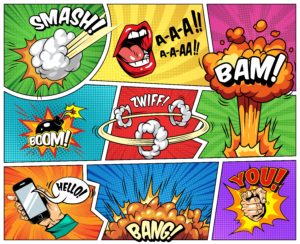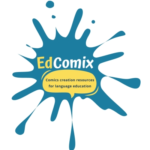Today, educators from all levels are designing new ways of teaching, elaborating methods and making use of every medium available that could fit in their classroom settings and needs. In search of expanding their resources to offer high quality and meaningful learning experience, or to overcome classroom challenges, many teachers have begun to introduce comics and started to think of creative ways to use the medium in the classroom.
Comics can be a useful tool in the hands of teachers to help engage students in the learning process as we have seen in a previous article ‘Comics for Education: An engaging teaching and learning approach’. Moreover, comics can help teachers present their lessons differently, support students in developing reading and writing skills, engage their creativity and other high-level thinking skills.
Specifically, by using comics and graphic novels, teachers are able to vary learning styles and to get more productive and efficient collaborative learning. Students who are stronger in text-based readings can work closely with visual learners and increase their confidence in written material as well. It is clearly a medium that attracts the interest of students and can be very helpful for slow readers and learners with learning difficulties or Specific Learning Disorders (for more on this topic see our previous article about ‘Comics for students with SLD: How it can work?’.
In addition, the graphic novel can serve as a great way to make connections with everyday life and students’ experiences. Amongst the various types of comic books and graphic novels that exist, teachers can offer to their students a selection of each and let them find out their own style and preferences – what is working for the classroom and what is not so effective.
Furthermore, there are many ways teachers can use comic in their classrooms depending on their objectives and needs. For instance, it is one thing to introduce comic strips, graphic novels and comic pages, but teachers and students can also explore comic creation and foster even greater creativity, skills in writing, reading and logic and critical thinking. Teachers can opt for comic creation to provide tailored made material for their students or create comics in the classroom with them, either handwritten or in digital forms. Several online tools and platforms exist today to support this effort, relieving teachers from being able to draw to create their own comics for the classroom. However, they also need guidance as to how to integrate comics in their lessons and in the wider school programme.
In fact, comics and graphic novels are still something very new in the toolbox of most teachers and even though teachers are willing to recognise comics’ potential, they may lack confidence and instructions. Statistically, while more than 98% of teachers surveyed by the French Association of Publishers stated that they perceived the pedagogical potential of comics, only 30% of them had use them as part of their teaching practice in the previous year, mostly due to a lack of practical guidance.
In respond to this need, we are working on the Erasmus+ funded European project EdComix to introduce a new methodology to make the most out of comics in education, specifically for language learning. In this framework, we have already developed and launched our first project output: a Pedagogical Guide on Using Comics for Inclusive English Education. The guide is targeted for teachers, trainers, language teachers and educators, but also to any person interested in gaining insights on how comics can help in education and language teaching and learning.
In particular, the guide intends to establish the pedagogical value of using comics in education and in particular to teach English in an inclusive way. In its pages, readers can have an overview of what comics are and how they can be used as a tool for learning inside the classroom, but also a focus on language classrooms, with examples of practical uses as well as activity suggestions teachers can use and adapt to their needs. Finally, we have devoted the last part of the guide to present how comics can support inclusive and participative teaching practices in language learning, for learners with Specific Learning Disorders, but also with regards to diverse cultural backgrounds.
Are you interested in learning more about teaching using comics?
Check the EdComix official website, which is available in 5 languages, and the official project Facebook page in English as well!
Resources :
https://www.freepik.com/vectors/frame – Frame vector created by dgim-studio – www.freepik.com
An Erasmus+ project
Visit the project’s website![]() Follow the project on Facebook : @EdComix
Follow the project on Facebook : @EdComix
In collaboration avec : YuzuPulse, ‘Mihai Bacescu’ Technical College, Areadne, Babel idiomas, Citizens in Power
